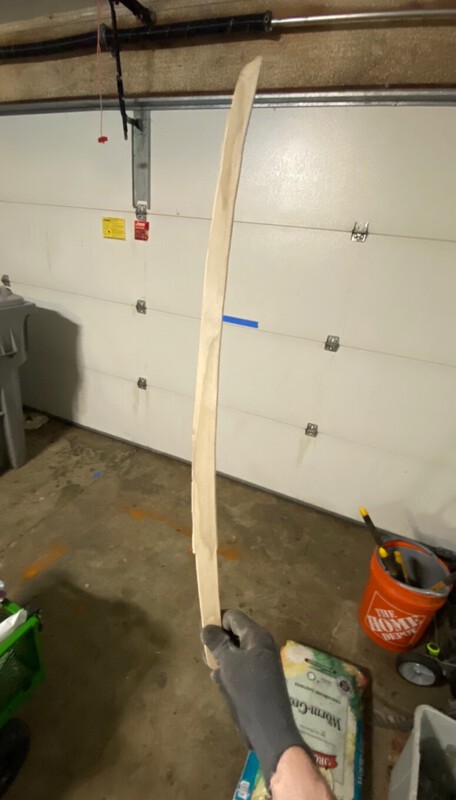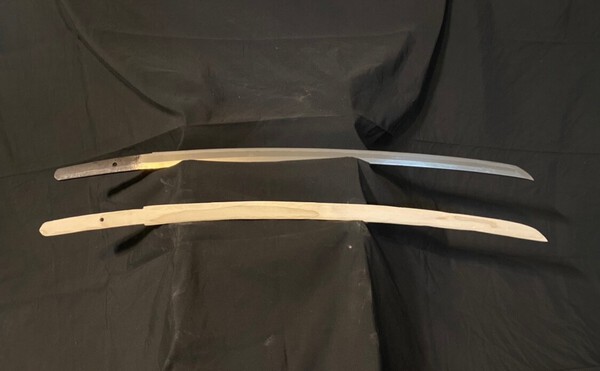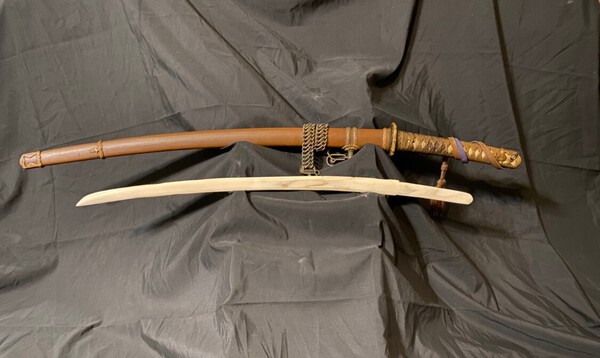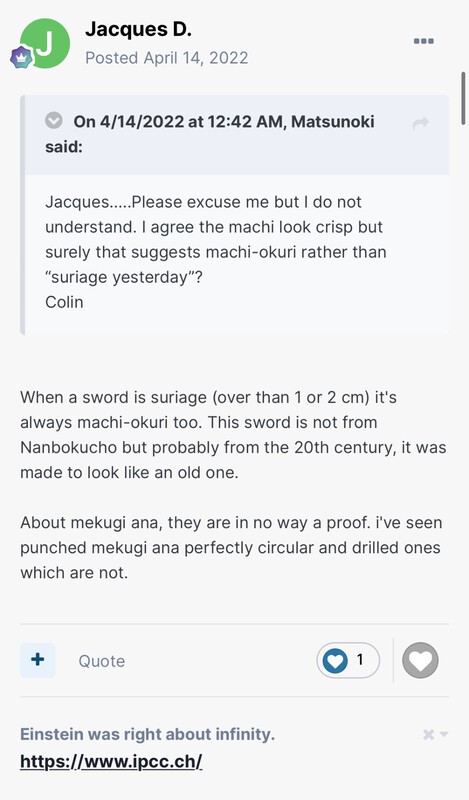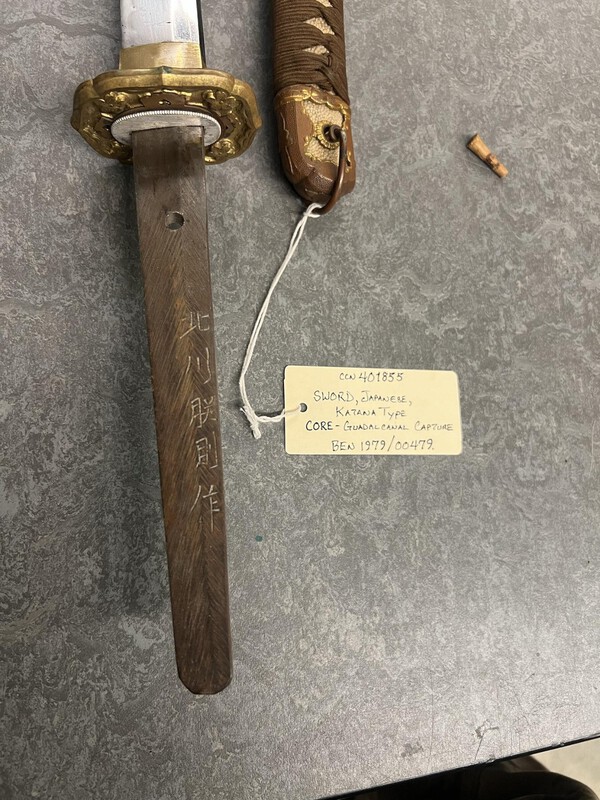-
Posts
1,118 -
Joined
-
Last visited
-
Days Won
7
Everything posted by Scogg
-
Well I made another one for my Type98 This one was tough, and ended up a bit more crude than my first. I used a harder wood. The shinogi-zukuri shape was considerably more challenging… and I would say I failed at establishing it That being said, it fits great, and holds the koshirae together nicely! Here’s some photos I took along the way. I followed the same method described in my comment above (while being constricted to the tools that I have at hand. Better/more tools would have made it much easier)
-
With all due respect, Jacques, You used absolutes like “this sword is not from nambokucho” and “it was made to look like an old one”. The underlined qualifiers imply that you’re certain. A certainty that you simultaneously imply is impossible to gleam from mere photos. Which is a source of confusion. Are you saying that you can definitively determine or eliminate an age/era from photos, but not the school or smith? Sincerely, -Sam Attached is a screenshot of the comment in question:
-
I share your desire for a nice Kyu Gunto Brian, and often browse what’s out there too. Poor condition and photos aside… I like the leather cover and don’t see that all the time on these. The two pins are intriguing, and makes me really wanna see that nakago! Some bigger emperor nodes on that samegawa I see. It also looks like it has some nice length and Sori (but thats harder to tell) All the best, and thanks for sharing, -Sam
-
Thank you Bruce and @The Blacksmith . That’s interesting and helps. I’ll dig around the forum some more too thanks again! cheers, -Sam
-
It looks older than WW2 to me, but you should wait for more informed opinions before drawing any conclusions. Here’s your photo oriented upright for those who can translate the Kanji on the nakago best of luck! -Sam
-
The wooden interior is something I've wondered about myself! Thank you @Bruce Pennington for that diagram and photos. I've been messing around with wood projects, so this interests me. A few questions if you remember from dismantling your Mantetsu: - Any idea on the type of wood used? - Are the inserts glued together at any point? - Or are they simply held together with tension by the exterior metal saya? - Is that a small wooden peg/notch on the kissaki end? Thanks again, Cheers, -Sam
-
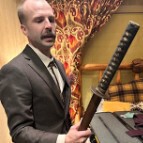
WW2 Japanese sword Amahide kore wo kitaeru”
Scogg replied to Swords's topic in General Nihonto Related Discussion
According to the seller info, it does have a hamon - it just “isn’t highly visible”. Hoso seguha is a very narrow and straight hamon pattern. Although I cannot see it in the photos. From what I can see, that is not a particularly rare ww2 tsuba like the seller suggests. The blade appears to be in standard type 98 fittings. With an engraved habaki which is a little fancy if it’s nice... But I can’t see it clearly. Lots of red flags in the overly romantic description, and really poor photos, and probably poor polish. I’d stay away from this one personally -Sam -
I document my collection and keep notes. Although, I keep a healthy understanding that I am NO EXPERT, so I do it in pencil (incase I need to edit things as I learn more) I keep notes about its size, features, and activity. I also note when and where I acquired them item. I do something similar for most my collections. Below is an example of a Wakizashi I shared on here recently, that I made the Tsunagi for. All the best, -Sam
-
The internet is a minefield; best to not let it distract from the blade in question Luckily, we’ve got a top-tier mod in Brian! Do you have more photos of this sword? Or was this from an internet post or listing? I’d love to see more All the best, -Sam
-
@Georgecar Sounds like a pretty specific topic that has little to do with this thread. I see you've posted a near identical paragraph on other threads. Right now, this is giving big "internet bot" vibes - no offense... If this is something you wish to discuss, I'd recommend starting your own forum topic and maybe naming who exactly you are referring to? Cheers, Sincerely, -Sam
-

US Army Infantry Collection: Translation Assistance
Scogg replied to chgruener's topic in Translation Assistance
For posterity, and those who can't open imagur* Looks like a nice Type 98 Gunto with a pierced(?) tsuba -
Thanks ya'll! Very kind words! @Wayben, probably not anytime soon for the Shirasaya. Although, I would love to learn a craft like that from a professional. Like everything Nihonto, I'm told it's no easy task, and would require some training and mentorship to do it correctly. I imagine some special tools too. I'm still relatively young, so maybe someday! My next challenge will be making a shinogi-zukuri tsunagi for a longer blade. I'm also working on an antler kake for myself. I'll photo document my process next time - but for now here's a synopsis (i'm sure there are better ways). I used an 8mm plank of wood from a craft store, and measured the blade with plastic calipers. I then drew the blade on the piece of wood with a pencil, and used a dremel tool to cut out a rough blade shape. I then widdled it down with a pocket knife to get a closer blade shape and establish a slight bevel. From there, I took some more precise measurements, and established the mune-machi and ha-machi locations. After that, it was all sandpaper and filing - being careful to sand an iori-mune at the mune-machi. *The hardest part was getting the habiki to fit, and I was surprised how thin the piece of wood needed to be. especially at the edge. (probably no surprise to ya'll ).* *I used a photo of the blade and measurements for reference, and took the sanding and filing to another room (Don't want to get sand paper particles all over the blade).* *Being extra careful to clean the wood of particles before attempting a fit (see above ^).* *All said and done, I learned a lot. I ended up with a slightly different blade geometry, but at least it fits!* My motives are to be crafty and practice, rather than entrepreneurial. Unfortunately I work too much right now. Thanks for reading my long winded comment, Edit: added side by side photo, and the next blade I hope to make a Tsunagi for, from my type 98. Cheers, and all the best! -Sam
-
Thanks Stephen! Thankfully the blade is hira-zukuri, and not very long. A good length and shape for a first try. Otherwise I think I would have failed or given up! Cheers, -Sam
-
Got bored today and decided to try to make my own Tsunagi for a Wakizashi I’ve got. It’s an out of polish, mumei blade with WW2 leather saya cover. Anyway, the process gave me a whole new appreciation for the precision of koshirae craftsman. Wow, it was challenging to fit! Just sharing for the sake of sharing, All the best, -Sam
- 11 replies
-
- 10
-

-

-
I’ve heard similar advice before from experienced collectors, and would like to try a good machine oil myself. Would you mind sharing what kind you use? I have both a high quality choji oil from Bob Benson, and also the oil from Stephens photos. I prefer Stephens recommendation, and like the cloth it comes with. And because the smell of choji oil reminds me of dental procedures Cheers, -Sam
-
1. During the war, the government requested that families donate their swords for the war effort (assuming the particular blade was not culturally significant to Japan). Many families donated swords to be used in WW2. These swords were refitted with military issue fittings to a greater or lesser extent. Also, after the war, Japan was "disarmed" and a lot of swords and weapons were taken by allied forces - and many others were tragically destroyed. 2. There are great stories about Naginata being used by women. Although, who's to say exactly how yours was used and when. There's a very interesting and brutal story about a Naginata wielding woman named "Nakano Takeko"... If you are interested, it's absolutely worth reading or finding a podcast about her. Looking forward to the discussion here, Cheers, -Sam
-
To add a bit to an already interesting discussion: I use microfiber cloths. I used to use a brand called microdeer, but they're no longer available. So I use clean microfiber cloth that would typically be used for eyeglasses. Good advice, as always, from Colin, Jean and Brian Best of luck, -Sam
-
Here's a couple really informative and helpful articles about green papers by Darcy Brockbank. Also a NMB forum topic about the subject. Definitely worth considering before you buy. https://web.archive....en-papers-no-papers/ https://web.archive....m/green-papers-pt-2/ That being said, Toryu gives great advice - to buy the koshirae/sword and not the paper/attribution Best of luck, -Sam
-
That’s a really good one Stephen. I like it. Those antler ones are crazy expensive! Antlers and antler sheds are so common out here, I might try to make one for myself Cheers, -Sam
-

Could someone help me identify this sword
Scogg replied to DannoTheManno's topic in Military Swords of Japan
With blades like this, of mystery origin and questionable craftsmanship, my first step would be trying to determine if it’s a functional sword. If it’s an unhardened strip of metal, then it’s almost certainly a fake If it’s hardened steel and full tang, then maybe it’s a real sword from somewhere Outside my expertise and focus, so grain of salt and all that… my gut says fake, but I’m prepared to be wrong. -Sam -
The left one has "spines" along its back and tail. Other than that, one is over the shinogi and the other is on *a hira-zukuri blade?* blade without a shinogi. Making me think the proportions might be very different. Even if not genuine Nobuhide, it looks decently carved from my novice eye. I imagine it would look nice if the sword were in better polish. Looking forward to everyones take! All the best, -Sam
-

shirasaya question and patterns in the hamon
Scogg replied to ysake's topic in General Nihonto Related Discussion
The black thing on the shirasaya is a horn insert for the mekugi. Like Brian said, it’s a decorative addition As far as the blade activity goes, it would help to see the tanto itself. But it’s challenging to capture some of that subtle activity in photography Best of luck, -Sam -
$30 for two drinks is a terrible deal! Jokes aside, it looks really nice! Sounds like it was meant to be yours. Funny how items find us sometimes. All the best, -Sam
-
I'd start with your fingers... and if that's not working maybe a pair of pliers; but with a rag/towel between the metal of the pliers and the metal of the screw (so you don't scuff/scratch/stamp the sides of the screw with the plier tread) Hope that makes sense, Best to go slow and be careful, Cheers, -Sam *Edit: If all else fails, there might be a fellow NMB member from Vermont who could help out in-person.





